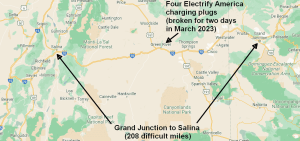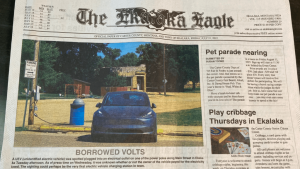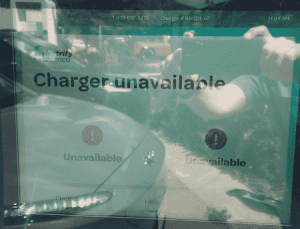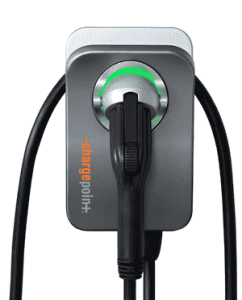It is fatiguing to read yet another consumer story about things going wrong when renting an EV (Washington Post, July 28, 2023). See also Car-Rental Companies Are Ruining EVs, The Atlantic, June 13, 2023, and What’s with the surprise EV at the rental counter?, The Globe and Mail, July 2, 2023, and Should you rent an electric car for a family holiday?, EV Central, July 5, 2023 (answer: “God no. Just don’t.”). Each story recounts all of these problems:
-
- The reporter can’t figure out where the charging port is on the vehicle.
- The reporter can’t figure out how to open the charging port.
- The reporter can’t find a charging station.
- The reporter has range anxiety.
- When the reporter reaches a charging station, it took way too long to charge up the EV.
- When the reporter reaches a charging station, the reporter found that all charging plugs were in use and the reporter had to wait too long for a charging plug to be available.
- When the reporter reaches the charging station, it’s broken.
- The reporter cannot figure out how to get the charging station to start charging the EV.
- When the charging is finished, the reporter cannot figure out how to unplug the charging plug from the charging port.
- The reporter returns the car at the end of the rental period and gets dinged for having failed to recharge it sufficiently.
The reporter never quite comes out and says it, but reading between the lines, one figures out that the reporter had, until now, only ever driven ICE (internal combustion engine) vehicles. The car rental experience, reported in sad detail in the consumer story, turns out to represent the first time ever that the reporter had operated an EV. It likewise eventually becomes clear that the place where the reporter went to carry out this experiment in first-time EV driving is a geographic location where the reporter has never been before!
From the point of view of the car rental company, it is easy to appreciate why some car rental companies actually prefer EVs in some ways. The cars are simpler mechanically, and do not break down as often. They do not require oil changes or lube jobs. But while the vehicles themselves might be low-maintenance, there is the risk that the rental customer (like the reporter in the consumer story above) might be high-maintenance.
There are rental car companies that have a cheapo last-minute rental option where you are quoted a cheap rental rate for a car that you are going to pick up today, and the catch is you agree in advance not to complain about it no matter what kind of car they give you. The consumer story goes on at length about how the reporter got stuck with an EV, and they had never before in their life touched an EV, and everything about the rental experience was miserable, and it was a disaster, and the main thing they learned from it is that nobody should ever purchase an EV and they want everybody to know it.
One can draw several lessons from such consumer stories:
-
- The best person to rent an EV from a car rental company is — guess what — somebody who already drives an EV.
- If you are going to rent an EV and are not sure about whether or not you can find charging locations, for goodness sake rent a Tesla so that you can use Tesla supercharging stations. There will always be plenty of Tesla supercharging stations just about anywhere that you might go.
- If you are going to rent an EV and are worried about whether you might get to a charging station and find that it is broken, for goodness sake rent a Tesla so that you can use Tesla supercharging stations. Tesla supercharging stations tend to not be broken. In the very rare event that a particular Tesla charging plug at a Tesla charging station turns out to be broken, there will be at least seven other plugs at that charging station and they will be working.
- If you are going to rent an EV and are worried about whether you might get to a charging station and find that it only charges an EV very slowly, for goodness sake rent a Tesla so that you can use Tesla supercharging stations. They charge EVs fast.
- If you are going to rent an EV and are worried about whether you might get to a charging station and find that you will have to wait your turn to use a charging plug, for goodness sake rent a Tesla so that you can use Tesla supercharging stations. Many of them have lots of charging plugs. There are Tesla supercharging stations with fifty or seventy-five or a hundred charging plugs. Every now and then you might have to wait, but quite often you will find you won’t have to wait.
- Don’t wait until you return the EV at the end of the rental period to find out what the rule is for how much you needed to charge it up. Find out ahead of time, and plan ahead if necessary to charge up the EV before returning the car. This might include figuring out where the nearest Tesla supercharging station is to the rental car return location.
- Be aware that mere level-2 charging stations only charge at level 2 speed (duh!). This means that at a level-2 charger, if your battery is low, it might take eight hours to charge up your EV.
- If you have never driven an EV before, maybe think twice before renting an EV.
- If you have never driven an EV before, and the place where you are planning to rent a car is a place where you have never been before, maybe think twice before renting an EV.
- If you are thinking of renting an EV, maybe think twice before renting a non-Tesla EV.
- Maybe don’t use the cheapo last-minute rental option where you are quoted a cheap rental rate for a car that you are going to pick up today, and the catch is you agree in advance not to complain about it no matter what kind of car they give you, if you are unprepared for the kind of car that they might give you.




